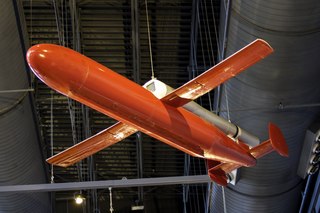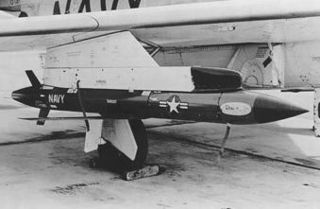
The Fairey Firefly is a Second World War-era carrier-borne fighter aircraft and anti-submarine aircraft that was principally operated by the Fleet Air Arm (FAA). It was developed and built by the British aircraft manufacturer Fairey Aviation Company.

The McDonnell XP-67 "Bat" or "Moonbat" was a prototype for a twin-engine, long-range, single-seat interceptor aircraft for the United States Army Air Forces. Although the design was conceptually advanced, it was beset by numerous problems and never approached its anticipated level of performance. The project was cancelled after the sole completed prototype was destroyed by an engine fire.

The Douglas C-1 was a cargo/transport aircraft produced by the Douglas Aircraft Corporation for the United States Army Air Service starting in 1925.
The Nakajima B3N was a prototype Japanese carrier-based torpedo-bomber aircraft of the 1930s. A single-engined biplane with a crew of three, it was unsuccessful, only two being built.

The Interstate XBDR was a design for an assault drone - an early television-guided missile - powered by two jet engines, that was designed by the Interstate Aircraft and Engineering Corporation during the latter stages of the Second World War for use by the United States Navy. Wind tunnel tests of a scale model were conducted, however no full-scale examples of the aircraft were built before the project was cancelled.

The Radioplane Q-1 was an American target drone, developed in the early 1950s for the United States Air Force by the Radioplane Company. Originally powered by a pulsejet engine, then later developed as an improved turbojet-powered aircraft, the Q-1 failed to win the favor of the USAF. However, the aircraft provided the basis of the GAM-67 Crossbow anti-radar missile.

The McDonnell TD2D Katydid was a pulsejet-powered American target drone produced by McDonnell Aircraft that entered service with the United States Navy in 1942, and continued in use until the late 1940s.

The Curtiss-Wright KD2C Skeet was an American target drone produced by Curtiss-Wright for the United States Navy that began development in 1945. The KD2C-1 first flew in 1947; however, it was found unsatisfactory and the program was cancelled in 1949.

The Globe KD5G is a pulsejet-powered American target drone produced by Globe Aircraft Corporation that began development in 1949. Due to changing requirements for drone performance, it was only operated by the United States Navy for a short period.
The Globe KDG Snipe was an American target drone, built by the Globe Aircraft Corporation for use by the United States Navy. The KDG, and its modified version, the KD3G Snipe, served between 1946 and the early 1950s.

The Temco XKDT Teal was an American rocket-propelled, high-performance target drone, built by Temco Aircraft for evaluation by the United States Navy in the late 1950s. Production was not proceeded with following evaluation of the type.

The Globe KD6G Firefly is an American target drone, built by the Globe Aircraft Corporation for operation by the United States Navy during the 1950s and early 1960s.

The Radioplane XKD4R, known by the company designation RP-70, was an American target drone developed by the Radioplane Division of the Northrop Corporation. Although it was not produced in quantity, it was developed into the successful AQM-38.

The Nord CT.41 Narwhal was a French target drone, designed and built by Nord Aviation during the late 1950s for the purpose of providing training in the interception of supersonic bomber aircraft.

The Naval Aircraft Modification Unit KDN Gorgon, originally designated TD2N, was an early jet-powered target drone developed by the Bureau of Aeronautics and constructed by the Naval Aircraft Modification Unit for use by the United States Navy. First flown near the end of World War II, it was cancelled due to problems with its engine in 1946.

The Radioplane OQ-17 was a target drone produced by the Radioplane Company for the United States Army Air Forces and, as the TD4D/KDR Quail, the United States Navy. Suffering from an unreliable engine, the OQ-17 production run was cut short in favor of the OQ-19.
The Aviolanda AT-21 was a target drone developed in the Netherlands by Aviolanda. Powered by a pulsejet engine, it was the Netherlands' first drone to be successfully developed, and saw limited use in the late 1950s and early 1960s.

The AUM-N-6 Puffin, also known as Kingfisher F and AUM-6, was an anti-ship and anti-submarine missile developed for use by the United States Navy in the late 1940s. Pulsejet-powered and intended to allow an aircraft to launch a torpedo or bomb from stand-off range, it was flight-tested but failed to enter operational service.
The Nihon L7P was a Japanese military seaplane built in World War II in the early 1940s.

The Mitsubishi Ka-12 or B4M was a Japanese carrier-based torpedo bomber of 1934. Two prototypes were built by Mitsubishi for the Imperial Japanese Navy. A development of the company's 3MT10 of 1932, the design differed primarily in the use of a radial engine and metal wing, which made the whole aircraft significantly lighter and faster. However, the design could not realise its potential as the wing was inefficiently stiff and the B4M was not selected for production. The competing Yokosuka B4Y was chosen to serve on the Navy's aircraft carriers instead.

















